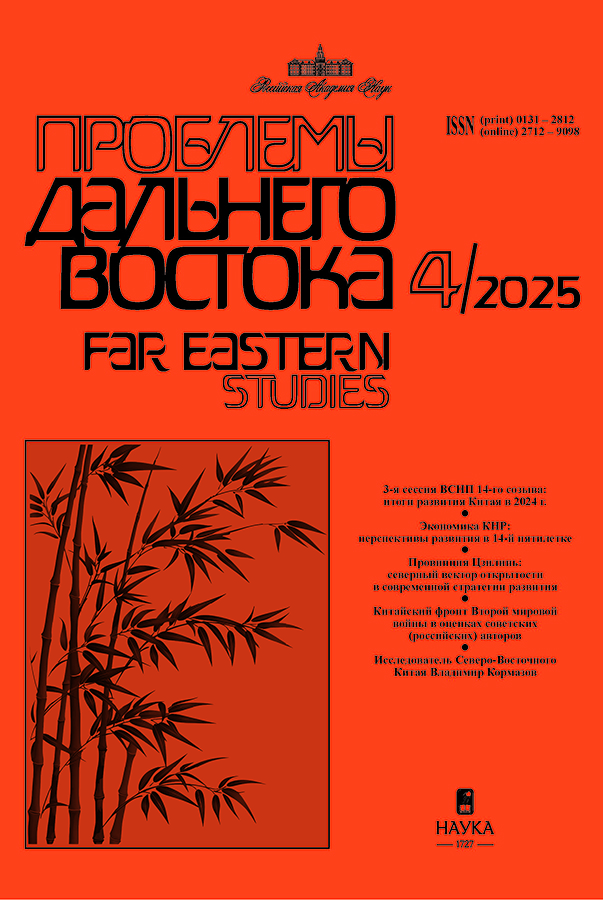Inner Mongolia: Strategic Positioning of China's Northern Periphery
- Authors: Namzhilova V.O1
-
Affiliations:
- Institute of Mongolian, Buddhist and Tibetan Studies, Siberian Branch, Russian Academy of Sciences
- Issue: No 5 (2024)
- Pages: 97-108
- Section: Economics
- URL: https://rjmseer.com/0131-2812/article/view/676257
- DOI: https://doi.org/10.31857/S0131281224050071
- ID: 676257
Cite item
Abstract
The article provides an overview of the current situation of China’s northern periphery — the Inner Mongolia Autonomous Region, regarding its economic dynamics, demographic parameters and current agenda. What is new is the consideration of the “strategic positioning” approach, when the region’s mission is defined in close connection with national interests. The author reveals the essence of the “five great tasks” assigned to the Inner Mongolia Autonomous Region by Xi Jinping: the creation of “two barriers”, “two bases” and “one bridgehead”. The first task — creating an “ecological barrier in the north of the country” — emphasizes the unique role of the Inner Mongolia Autonomous Region in the national environmental protection system. The second task — ensuring a barrier of security and stability — is based on the importance of maintaining national unity and tranquility on the northern borders. The third task — creating a national base of energy and strategically important resources — is associated with advanced practices in the production and supply of electricity, as well as deep processing of rare earth metals. The fourth task is aimed at creating a base for the production of agricultural products to ensure China’s food security. And the fifth task is to build a "bridgehead for opening up to the North", stimulating close cooperation with northern neighbors. Understanding the internal processes in adjacent to Russian regions China’s Inner Mongolia is extremely important for building international ties. Particular attention should be paid to the task of "openness to the North", which is gaining new impetus with the activation of Russia's "turn to the East". The counter movement of these strategies, coupled with the Mongolian "New Revival Policy", create favorable conditions for the construction of the China-Mongolia-Russia Economic Corridor.
About the authors
V. O Namzhilova
Institute of Mongolian, Buddhist and Tibetan Studies, Siberian Branch, Russian Academy of Sciences
Author for correspondence.
Email: dayavika@yandex.ru
ORCID iD: 0000-0001-7362-4701
Ph.D. (Economics), Senior Researcher, Department of Regional Economic Studies
Ulan-UdeReferences
- Anohin A.A., Kuzin V.Yu. Podhody k vydeleniyu periferii i periferizaciya v prostranstve sovremennoj Rossii [Approaches to the allocation of periphery and рeripheralization in the spatial development of modern Russia]. Izvestiya Russkogo geograficheskogo obshchestva. 2019. No. 1 (151). S. 3–16. doi: 10.31857/S0869–607115113–16. (In Russ.)
- Dondokov Z.B.-D., Namzhilova V.O. Ekonomicheskij koridor Kitaj — Mongoliya — Rossiya: vystraivanie infrastrukturnoj svyazannosti v usloviyah global'nyh vyzovov [China — Mongolia — Russia Economic Corridor: constructions infrastructure connectivity in the time of global challenges].
- Kondrashova L.I. Kitay ishchet svoy put′ [China is looking for its own path]. M.: Institut Dal’nego Vostoka Publ., 2006, 320 s. (In Russ.)
- Larin V.L. Rossiysko-kitayskoye transgranich′ye v kontekste proyektov yevraziyskoy integratsii [Russia — China transboundary region from the perspective of Eurasian projects]. Mirovaya ekonomika i mezhdunarodnye otnosheniya. 2016. No. 12. S. 69–81. (In Russ.)
- Намжилова В.О. Внутренняя Монголия как энергетичNamzhilova V.O. Vnutrennyaya Mongoliya kak energeticheskiy forpost Kitaya [Inner Mongolia as energetic frontier of China]. Aziya i Afrika segodnya. 2020. No. 2. S. 22–29. doi: 10.31857/S032150750008469–7. (In Russ.)еский форпост Китая // Азия и Африка сегодня. 2020. № 2. С. 22-29. doi: 10.31857/S032150750008469-7
- Namzhilova V.O. Ekonomicheskoe razvitie ARVM v nachale 21 v. [Economic Development of IMAR in the Beginning of 21st century]. Problemy Dal'nego Vostoka. 2019. No. 3. S. 73–81. doi: 10.31857/S013128120005301–2. (In Russ.)
- Namzhilova V.O. Vnutrennyaya Mongoliya KNR: dinamika social'no-ekonomicheskogo razvitiya i orientiry 14-j pyatiletki (2021–2025 gg.) [Inner Mongolia of the PRC: Dynamics of Socio-Economic Development and Landmarks for the 14th Five-Year Plan (2021–2025)]. Aziatsko-Tihookeanskij region: ekonomika, politika, pravo. 2022. No. 2. S. 24–35. doi: 10.24866/1813–3274/2022–2/24–35. (In Russ.)
- Pestsov S.K. Trudnaya periferiya: strategiya i rezul′taty ozhivleniya «rzhavogo poyasa» Kitaya [Difficult peripherals: strategy and results of revitalizing the “rust belt” of China]. Aziatsko-Tikhookeanskiy region: ekonomika, politika, parvo. 2020. No. 3. S. 126–136. (In Russ.)
- Samburova E.N. Regional′nyye disproportsii sovremennogo razvitiya ekonomiki Kitaya [Regional disparities in the present-day development of China’s economy]. Vestnik Moskovskogo universiteta, series 5: Geografiya. 2014. No. 4. S. 49–55. (In Russ.)
- Stavrov I.V. «Vozrozhdeniye Severo-Vostochnogo Kitaya» v programmnykh dokumentakh Pekina v nachale XXI v. [«Revival of Northeast China» in the program documents of Beijing at the beginning of the 21st century]. Rossiya i ATR. 2017. No. 4. S. 69–87. (In Russ.)
- Chubarov I.G. Gosprogrammy regional′nogo razvitiya KNR v istoricheskom kontekste [State-level regional development programs in China]. Vostochnaya Aziya: fakty i analitika. 2020. No. 4. S. 21–32. (In Russ.)
- 奋力走进前列: 内蒙古现象研究 [Struggling to enter the forefront: a study of the phenomenon of Inner Mongolia] / 布和朝鲁 著. 北京: 人民出版社, 2009. 423 页. (In Chin.)
- 李向阳: 经济走廊建设: “一带一路”高质量发展的微观基础 [Li Xiangyang. Economic Corridor Construction: The Micro-Foundation for High-Quality Development of the Belt and Road]. 世界经济与政治. 2023年. 第10期. 第2–15页. (In Chin.)
- 内蒙古经济发展研究 [Inner Mongolia Economic Development Research] / 王来喜编者. 北京: 民族出版社, 2008年. 458页. (In Chin.)
- 中国西部经济发展报告 (2009) [Western China Economic Development Report (2009)] / 姚慧勤,任宗哲主编. 北京: 社会科学文献出版社, 2009年. 560 页. (In Chin.)
- 中蒙俄经济走廊建设重点问题研究 [Research on the main problems of the construction of China — Mongolia — Russia economic corridor] / 内蒙古自治区发展研究中心
- 内蒙古自治区经济信息中心 著. 北京: 人民出版社, 2016年. 421页. (In Chin.)
- 中蒙俄经济走廊研究报告 (2017) [Research Report on China-Mongolia-Russia Economic Corridor (2017)] / 包斯勤 主编. 北京: 社会科学文献出版社, 2018. 373 页. (In Chin.)
Supplementary files











